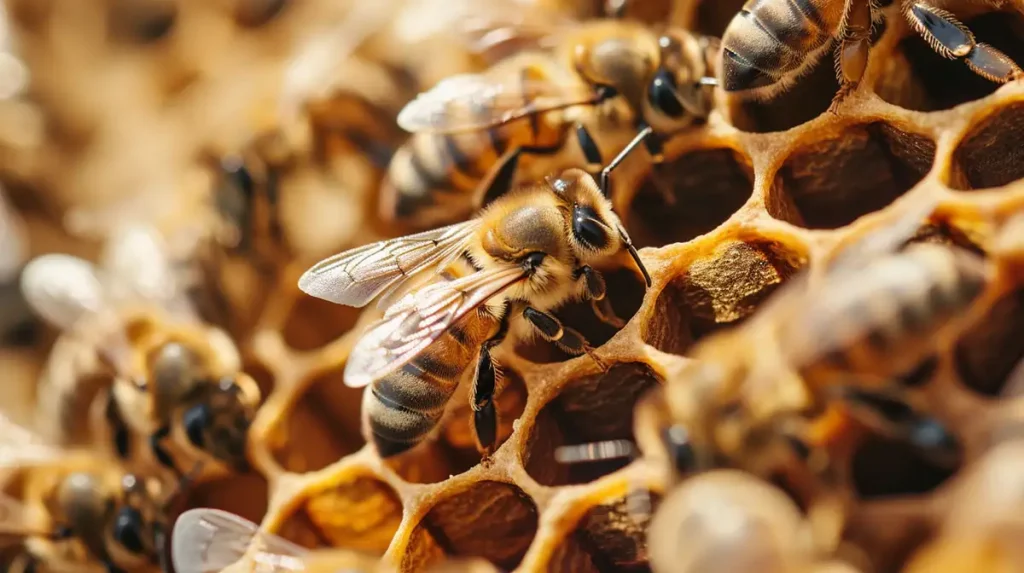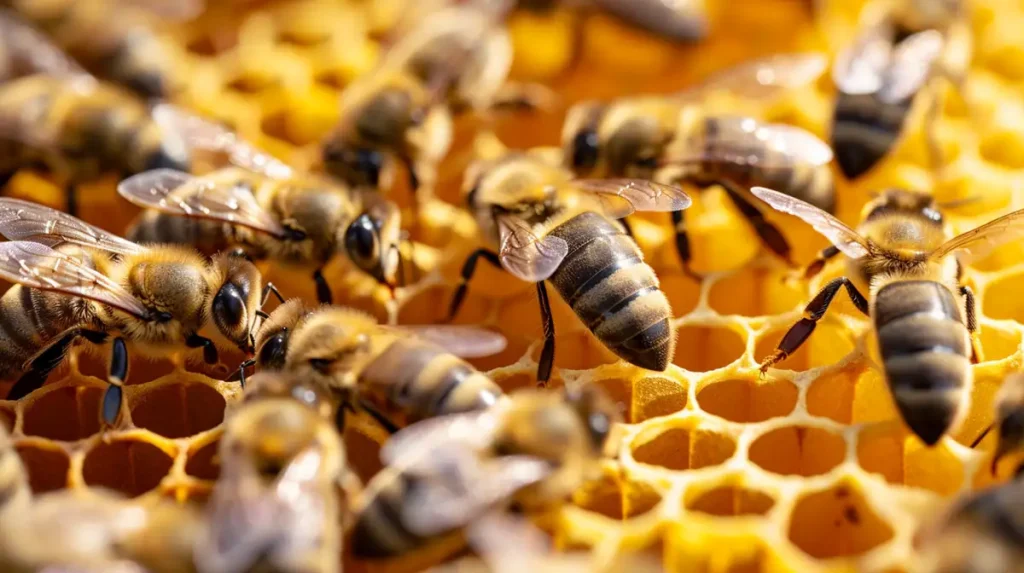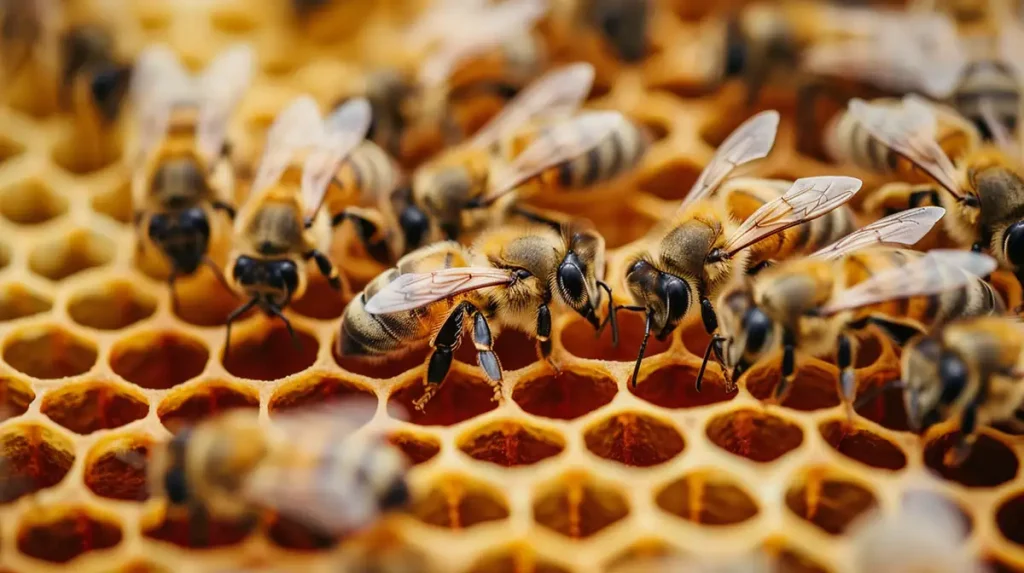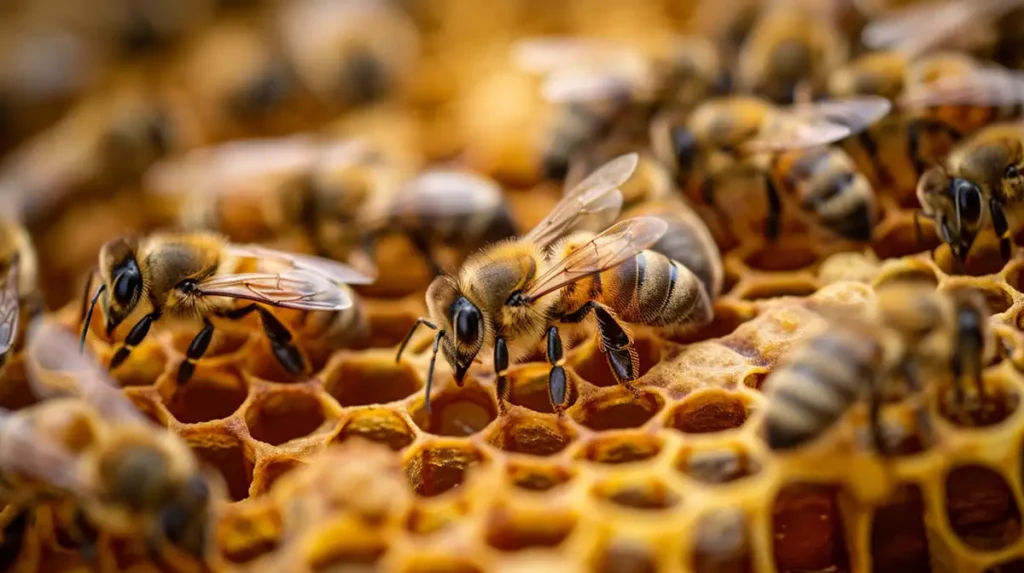Table of Contents
Honey bees reproduce through a process involving the queen bee mating with multiple drones (male bees) during a nuptial flight. The queen stores the sperm from these flights and uses it to fertilize eggs throughout her life, laying up to 2,000 eggs a day. Fertilized eggs develop into female worker bees or queens, while unfertilized eggs become male drones. When a new queen is needed, worker bees feed selected larvae royal jelly to develop them into queens, leading to the old queen leaving with a swarm to form a new colony.
In the below paragraphs, we will take a more detailed look at this topic.
Many people are naturally interested in learning about how different species reproduce, and it is no different when it comes to bees. However, if you are wondering how bees reproduce, you might be surprised to know that it is not really conventional (or conventional in the way we understand things).
Key Takeaways
- Bee reproduction is a complex process involving queen bees, drones, and worker bees, ensuring the survival and growth of a colony.
- Queen bees mate during a nuptial flight, where they leave the hive and mate with multiple drones in mid-air, ensuring genetic diversity within the colony.
- Drones are male honey bees whose primary purpose is to mate with the queen bee during the nuptial flight, after which they die.
- Worker bees, all female, play a crucial role in the reproductive process by taking care of the larvae, supporting the queen bee, and contributing to swarm preparation and swarming.
- Honey bees ensure genetic diversity in their offspring through a unique reproductive system involving haplodiploidy and polyandry.
- Bee reproduction rates can be affected by factors such as environmental conditions, genetic makeup, and colony health.
What Is The Bee Reproduction Process?
The bee reproduction process is a fascinating and complex natural phenomenon that occurs within bee colonies. This process can be broken down into several key stages, which ensure the continued survival and growth of a colony.
How Do Queen Bees Mate?
Queen bees mate during a process called nuptial flight, which typically occurs within the first few weeks of their life. The nuptial flight is a unique event in which the queen bee leaves her hive to mate with multiple male bees (drones) in mid-air. This event is crucial for the success and survival of the colony.
Nuptial Flight and Mating Process
Before the nuptial flight, the queen bee consumes a large amount of protein-rich royal jelly, which allows her to develop her reproductive organs and store sperm for later use. When the weather conditions are favorable, the queen takes flight and releases pheromones to attract nearby drones. These pheromones help the queen to form a “drone congregation area,” where numerous drones from various colonies gather to compete for the chance to mate with her.
The mating process itself is quite brief, lasting only a few seconds. The queen will mate with multiple drones, usually between 10 and 20, during a single nuptial flight. During the mating process, the drone’s endophallus is inserted into the queen’s sting chamber, transferring sperm. Shortly after mating, the drone dies as the act of mating causes his endophallus to break off.
Egg-laying and Brood Development
After mating, the queen bee returns to the hive and begins laying eggs in the cells of the brood comb. The queen can choose to fertilize an egg, producing a female worker bee or another queen, or leave it unfertilized, producing a drone. The egg-laying process is heavily influenced by the needs of the colony. For instance, if the colony requires more worker bees, the queen will lay more fertilized eggs.
Eggs hatch into larvae after three days, and worker bees then feed the larvae with a mixture of honey, pollen, and a glandular secretion known as royal jelly. The amount of royal jelly fed to the larvae determines their development. If a larva receives royal jelly throughout its development, it will become a queen; otherwise, it will develop into a worker bee. Drone larvae, on the other hand, are only fed with honey and pollen.
After about six days, the larval cells are capped by worker bees, and the larvae undergo metamorphosis, transforming into pupae. The pupal stage lasts around 12 days for worker bees, 16 days for drones, and 15 days for queen bees. After this period, the new adult bees emerge from their cells, ready to fulfill their roles in the colony.
The bee reproduction process is an intricate and delicate balance that ensures the health, growth, and continuity of a bee colony. As the colony thrives, it may eventually split through a process called swarming, where a portion of the colony leaves with a new queen to establish a new colony elsewhere. This fascinating process highlights the incredible adaptability and resilience of bees in the natural world.

What Is The Role Of Drones In Bee Reproduction?
Drones are the male honey bees in a colony and their primary purpose is to assist in the reproductive process. They are larger and stouter than their female counterparts, the worker bees, but smaller than the queen bee. Drones are equipped with large eyes and robust bodies, which aid them in their singular reproductive mission.
- Carter, Anthony (Author)
- English (Publication Language)
- 194 Pages - 02/28/2024 (Publication Date) - Independently published (Publisher)
Mating Flights and The Role of Drones
The drone’s role in bee reproduction begins when a virgin queen bee embarks on her mating flight. During this flight, the queen mates with multiple drones from different colonies, ensuring genetic diversity within the hive. As mentioned above, this mating takes place in the air, in areas known as drone congregation areas (DCAs), where drones from various hives gather in anticipation of a queen’s arrival.
Longevity of Drones
Drones have a relatively short lifespan compared to worker bees and queen bees. They typically live for around two months, during which their sole focus is to mate with a queen. If they are unsuccessful in their mission, they will eventually be expelled from the hive as resources such as food and space become more limited in the fall.
How Are Worker Bees Involved In Reproduction?
Worker bees, which are all female, play a critical role in the reproduction process of a honey bee colony. Although they are not directly involved in mating, their various tasks and responsibilities contribute to the overall success of colony reproduction. In the following paragraphs we’ll explore the different ways worker bees participate in the reproductive process.
Nurse Bees and Larval Care
One of the primary roles of worker bees is to serve as nurse bees, tending to the developing larvae in the hive. They are responsible for feeding the larvae royal jelly. This sustenance ensures the proper growth and development of the larvae. Nurse bees also help to maintain the ideal temperature and humidity within the hive to optimize larval development.
Supporting the Queen Bee
Worker bees are instrumental in supporting the queen bee, the sole reproductive female in the colony. They attend to her needs, groom her, and feed her royal jelly. By doing so, they ensure that the queen remains healthy and fertile, capable of laying thousands of eggs to propagate the colony.
Assisting in Mating Flights
Worker bees also help prepare virgin queens for their nuptial flights, during which they mate with multiple drones in mid-air. The worker bees will clear the hive entrance and release pheromones to signal the queen and drones that it is time to take flight. Once the queen has successfully mated, she returns to the hive and the worker bees assist her in laying eggs.
Swarm Preparation and Swarming
Finally, worker bees play an essential role in swarm preparation and swarming, which is the natural process of colony reproduction. When a colony becomes overcrowded, the worker bees will start preparing for swarming by raising a new queen. Once the new queen has emerged, the old queen leaves the hive with a large number of worker bees to form a new colony. The remaining worker bees stay behind to support the new queen and ensure the continuity of the original colony.
How Do Bees Ensure Genetic Diversity In Their Offspring?
Honey bees have a unique reproductive system that allows them to maintain genetic diversity in their offspring. This is crucial to the survival and resilience of a colony, as it helps to prevent inbreeding and ensures that the bees can adapt to changing environmental conditions. There are two primary mechanisms at work in honey bee reproduction: haplodiploidy and polyandry.
Haplodiploidy
Honey bees exhibit a sex determination system known as haplodiploidy. In this system, males develop from unfertilized eggs and are haploid, meaning they have a single set of chromosomes. Females (workers and queens), on the other hand, develop from fertilized eggs and are diploid, possessing two sets of chromosomes. This unique system allows for a greater variety of genetic combinations among the offspring since half of their genes come from their mother (the queen) and the other half from their father (the drone).
Polyandry
Polyandry is the practice of a female mating with multiple males. In honey bees, this occurs when the queen embarks on her nuptial flight.
This mating behavior results in a colony with a high degree of genetic diversity among its worker bees. Each worker bee is a half-sibling to the others, sharing only their mother’s genes while their father’s genes come from one of the many drones the queen has mated with. This genetic diversity contributes to the overall health and adaptability of the colony, as it increases the likelihood that some bees will have advantageous traits that can help them cope with diseases, pests, or changing environmental conditions.

What Factors Affect Bee Reproduction Rates?
Bee reproduction rates can be influenced by a variety of factors, ranging from environmental conditions to the genetic makeup of the colony. Understanding these factors is crucial for maintaining healthy and productive bee populations.
Environmental Factors
1. Temperature
Temperature plays a significant role in bee reproduction rates. Optimal temperatures for bee reproduction range from 64°F to 93°F (18°C to 34°C), with the most favorable temperatures being between 77°F to 86°F (25°C to 30°C). Cooler or warmer temperatures can hinder brood rearing and reduce the reproductive output of the colony.
2. Food Availability
Ample pollen and nectar sources are essential for the reproduction and growth of bee colonies. The queen’s egg-laying rate is directly influenced by the availability of these resources. When pollen and nectar are scarce, reproduction rates may slow down or cease altogether.
3. Pesticides
Exposure to pesticides can negatively impact the reproductive success of bees. Pesticides can impair the queen’s ability to lay eggs, reduce sperm viability in drones, and affect the overall health and survival of the colony.
Genetic Factors
1. Queen Bee Genetics
The genetics of the queen bee can greatly influence the reproduction rate of a colony. A queen with strong genetics will produce healthier offspring, increasing the colony’s overall productivity and survival.
2. Mating Diversity
A higher degree of genetic diversity in the mating process can result in a more robust and resilient colony. When a queen mates with multiple drones from different colonies, it increases the genetic diversity of the offspring, which can lead to improved resistance to diseases and environmental stressors.
Colony Health
1. Disease and Parasites
Diseases, such as American foulbrood, and parasites, like the Varroa mite, can have a detrimental effect on bee reproduction rates. These pathogens and parasites can weaken the colony, impairing the queen’s ability to lay eggs and reducing overall colony growth.
2. Colony Size and Age
The size and age of a colony can also impact reproduction rates. A larger and more established colony will typically have a higher reproduction rate than a smaller or younger colony. Additionally, as the queen bee ages, her egg-laying capacity may decrease, resulting in reduced reproduction rates.

How Do Bees Reproduce – Conclusion
Bee reproduction depends on a queen bee taking a mating flight, during which time she will mate with up to fifteen drones from another hive. Drones lose a part of their genitalia during the mating flight and die shortly afterwards.
The queen will store millions of spermatozoa in her spermatheca and will use them to fertilize eggs as and when determined by her. Fertilized eggs become female worker bees, whereas unfertilized eggs will hatch as male drones.
Last update on 2024-04-25 / Affiliate links / Images from Amazon Product Advertising API


